Lions, Tigers and Bears
by Mike Bullock (writer) and Jack Lawrence (artist)
Published by Image Comics (Berkeley, CA)
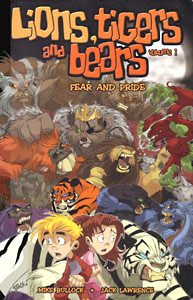 |
|
|
|
|
Volume One (Sep 2006) |
| ISBN: |
158240657X |
|
|
Color, 128 pages, USD $12.99 |
|
|
|
|
|
|
|
|
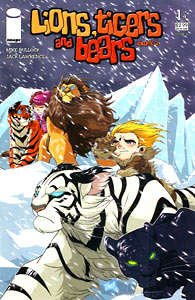 |
|
|
|
|
|
|
|
| Title: |
Volume Two (Feb 2008) |
| ISBN: |
1582409307 |
|
Color, 128 pages, USD $14.99 |
|
|
|
Lions, Tigers and Bears is an action/adventure comic aimed at kids by Mike Bullock and Jack Lawrence. It was originally published as a miniseries (four issues in 2005, and another four in 2006), which have since been reprinted in two trade paperbacks.
The story follows Joey, an easily-scared child with an active imagination who has just moved into a new house. Lonely without any friends nearby, his grandmother buys him The Night Pride, a set of four stuffed animal toys to protect him while he sleeps. As it turns out, the gift is a practical one. Nightmares aside, there actually are monsters in the dark attempting to kidnap children, and the Pride are magical toys made to fend them off.
As the toys come alive at night to fight the Beasties, Joey accidentally falls through a magical portal and finds himself in the Stuffed Animal Kingdom, where his guardians are life-size, and they need his help. Valthraax, the leader of the Beasties, has managed to capture the daughter of the toymaker who makes the stuffed animals. And the plot is off and running.
The Night Pride are Joey’s companions on his quest: Pallo (a lion, the leader), Venus (a Bengal tiger), Minerva (a sarcastic black leopard) and Ares (a white Siberian tiger and soon Joey’s best friend). Most of the remaining characters in the royal castle are bears, although other species occasionally appear in the background. All of the magical toys have glowing blue or green eyes, and while they’re genuinely strong and have real claws, injuries draw stuffing, not blood.
The only quibble I might have with the comic involves a sense of exaggeration. Joey’s head-to-body ratio is rather extreme, and the animals seem poised dramatically in almost every panel. Other than that, the artistic design and coloring in this comic are very effective. The story is simple but full of action, and being for kids, Joey’s ultimate triumph is overcoming his fears, gaining self-confidence, and understanding the power of imagination.
If you don’t mind the age group it’s written for, it definitely might interest people who are fans of… well, lions, tigers or bears. If you’re not sure about the artistic style, check your local library and give it a look-see. Also, the second volume appeared earlier this year (2008) and you may still be able to find it stocked in bookstores, without having to order it online.
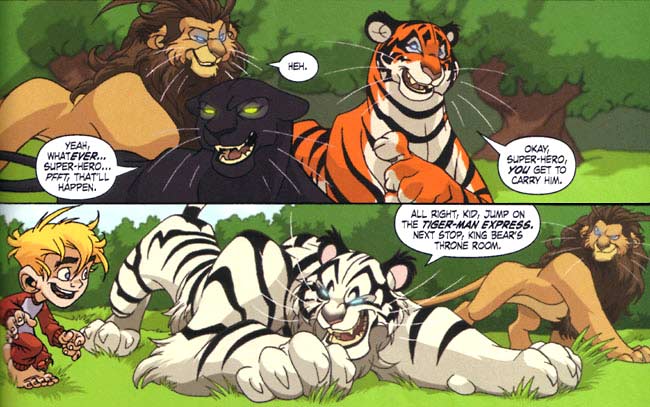
Like online comics, there are so many podcasts floating around these days that it can be difficult to find ones that work for you. Personally I’m fond of Escape Pod, a podcast for science fiction stories, where I found two great children’s fantasy tales by Pete Butler: Squonk the Dragon and its sequel, Squonk the Apprentice. I really, really enjoyed listening to these.
Squonk is a young dragon being raised by a bluebird named Mrs. Tweedlechirp, who found his egg sitting unattended in the forest. Unlike other dragons, Squonk is, well, nice, thanks to his upbringing. But his life in the forest is boring, until a wizard named Wendell shows up, looking for a place to live. Wizards typically live in huge stone towers, but this attracts apprentices, and Wendell hates apprentices. His solution? To make his home inside a giant tree! Which, unfortunately, is the same one occupied by Squonk.
Telling you anything more than that would ruin the plot. These are two simply delightful, fun stories full of good humor. Steve Eley, the host of the podcast site, reads them with his wife Anna. Her voice is a bit too high-pitched when she does Mrs. Tweedlechirp’s dialogue, but otherwise, they both do the text justice and make the characters come alive.
In fact, it’s entirely possible that Squonk would have grown up completely ignorant of ways to defend himself, were it not for a mysterious crow who’d wandered through the forest several years back. This crow had taught the small birds of the forest—and one not-so-small dragon—a defense he’d learned in his many travels. He called it “Woodpecker-Fu”. Wendell had never seen it before. Squonk demonstrated.
Squonk remembered the training. First, fly down to your enemy and flap like crazy so you hover in place. Second, look for some part of your enemy that would hurt a lot if you poked it. Third, peck vigorously until your enemy runs away. And that’s what happened, more or less.
The windstorm Squonk kicked up by all the flapping almost blew Wendell away all by itself. And the pecking wasn’t quite… vigorous, nor did the wizard exactly run away. It was more like, peck once—blast your enemy about a hundred yards through the air—then watch him run off with a pronounced limp. Just the same, Squonk felt very pleased with himself.
So give these a listen! They can be played on the website or downloaded as MP3s. And if these stories make you smile, send the site a couple of bucks, even if it’s just a dollar or two—Escape Pod is worth supporting for an hour’s worth of entertainment; they pay their contributors. You might also be interested in their two sister sites, PodCastle for fantasy fiction and Pseudopod for horror.
Hopefully the readers of Anthro are no strangers to Ursula Vernon and her wonderful comic, Digger (previously reviewed here and here). Good news! She’s branched into children’s lit and has presented us with Nurk: The Strange, Surprising Adventures of a (Somewhat) Brave Shrew, which she’s also illustrated. Nurk is a quiet, unassuming little shrew who lives in a willow tree by a stream.
More than anything, Nurk wanted to be like his grandmother Surka the warrior shrew. Surka had been a fighter, a dishwasher, and a pirate queen, and he was very proud to be related to her. Her portrait hung in his front hallway, and it was the first thing anyone saw when they entered his house. (Since the portrait showed her brandishing a severed head, this was a bit of a shock for first-time visitors, but Nurk’s love for the portrait was undimmed.)
Nurk receives a water-stained letter containing a desperate plea for help, obviously intended for his grandmother. Realizing it’s up to him to come to the rescue, the prospect scares him until he discovers Surka’s diary, which gives him the encouragement he needs to embark on his first, real-life adventure. Along his way, Nurk occasionally consults the diary, finding advice that isn’t especially useful but is amusing to read.
“Being in charge isn’t much fun. Sure you can sleep in late, but there are so many things to worry about all the time. The best plan for any sensible adventurer is to sweep in, take the throne, live like a king for a few weeks, and then sneak out in the middle of the night before people start asking unpleasant questions about road maintenance and tax relief.”
“There are fifteen of us, well-armed for anything that will come our way. I have a new sword and shield and the finest armor, made for me by the battle-hamster blacksmiths. Grohger Squeakingdeath keeps chewing on his shield. The other hamsters think he is a berserker, but I think he is just weird and needs to bathe more often.”
Finding the people who sent the letter, Nurk goes off to rescue the prince of the dragonflies from the terrible Grizzlemole, minimally equipped with a boat, a pair of socks and one purple toenail. Ursula Vernon’s writing is full of this sort of whimsical, absurd humor, and also a strong sense of atmosphere—Nurk’s descent into the Grizzlemole’s lair is evokingly eerie. Basically, I think this book would be an engaging read for kids, or a good short fluffy read for adults. For more information about Ursula Vernon and her work, check out her Metal & Magic website.
Blacksad
by Juan Díaz Canales (writer) and Juanjo Guarnido (artist)
Published by Dargaud, iBooks, Public Square Books
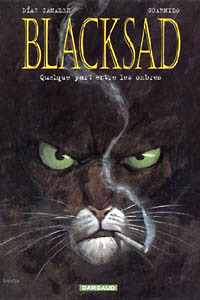
Cover of Dargaud edition of Blacksad v. 1 |
|
|
|
| Title: |
Quelque part entre les ombres
(French edition of Blacksad v. 1) |
| Publisher: |
Dargaud (France), Nov 2000 |
| ISBN: |
2205049658 |
|
|
Color, 48 pp, EUR 12.35 |
|
| Title: |
Somewhere within the shadows
(English edition of Blacksad v. 1) |
| Publisher: |
iBooks (NYC), Dec 2003 |
| ISBN: |
0743479912 |
|
|
Color, 54 pp, USD $12.95 |
|
|
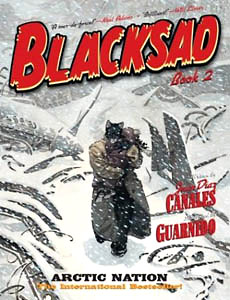
Cover of iBooks edition of Blacksad v. 2 |
|
| Title: |
Arctic nation
(French edition of Blacksad v. 2) |
| Publisher: |
Dargaud (France), Mar 2003 |
| ISBN: |
2205051997 |
|
Color, 56 pp., EUR 12.35 |
|
| Title: |
Arctic nation
(English edition of Blacksad v. 2) |
| Publisher: |
iBooks (NYC), Mar 2004 |
| ISBN: |
0743479351 |
|
Color, 56 pp., USD $12.95 |
|
| Title: |
Arctic nation
(Spanish edition of Blacksad v. 2) |
| Publisher: |
Public Square Books, Apr 2005 |
| ISBN: |
9781594971037 |
|
Color, 56 pp., $20.95 |
|

Cover of Dargaud edition of Blacksad v. 3 |
|
|
| Title: |
Âme rouge
(French edition of Blacksad v. 3) |
| Publisher: |
Dargaud (France), Nov 2005 |
| ISBN: |
220505564X |
|
|
56 pp, EUR 12.35 |
|
| Title: |
Alma roja
(Spanish edition of Blacksad v. 3) |
| Publisher: |
Public Square Books, Dec 2006 |
| ISBN: |
9781594972171 |
|
|
56 pp.,$22.95 |
|
|
|
 The comics scene in France is very different from the North American market. Sure, we know about Tintin and Asterix, but not much else. And that’s sad, because Europe turns out some really high-quality material. Although admittedly there are language differences.
The comics scene in France is very different from the North American market. Sure, we know about Tintin and Asterix, but not much else. And that’s sad, because Europe turns out some really high-quality material. Although admittedly there are language differences.
Most North American comics are in the superhero genre. They’re printed on 10" x 6.5" paper and come out once a month for $3 to $4. The production teams may involve as many as 5 people and can have story arcs stretching over 20 issues.
Comics in France are written in every genre imaginable. The pages are big (up to 12" x 9" on good paper), are bound in hardcover, and sell for around 12 euro. The production teams are frequently artist-and-writer duos. The time between issues can be as long as 1 to 2 years. And while there may be an overall story arc, the plot within any given issue is usually pretty self-contained. The market is active for both children and adults, and store shelves can have cutesy kid humor sitting right next to erotica. If this is difficult to imagine, think Smurfs… and then think Heavy Metal.
Of particular interest to furry fans is Blacksad, by the Spanish team of Canales and Guarnido. Created in the hard-boiled detective/film-noir genre, the comic is set in the U.S. during the 1950s and follows the exploits of a feline private investigator named John Blacksad. So far only three issues have appeared (in 2000, 2003 and 2005), but considering the quality of the artwork (in watercolor!), the delays are understandable.
All of the characters are depicted as humanoid animals without tails. Rather than actually being animals, they’re meant as an artistic caricature to exaggerate personality, physical appearance and mannerisms, with the occasional visual pun. Female characters appear more human than their male counterparts, and the police force is mostly canine. Blacksad himself is a black cat with a white muzzle and a trenchcoat. He’s both educated and street-smart, jaded yet hopeful, with an eye for the ladies but having all the bad luck of his kind.
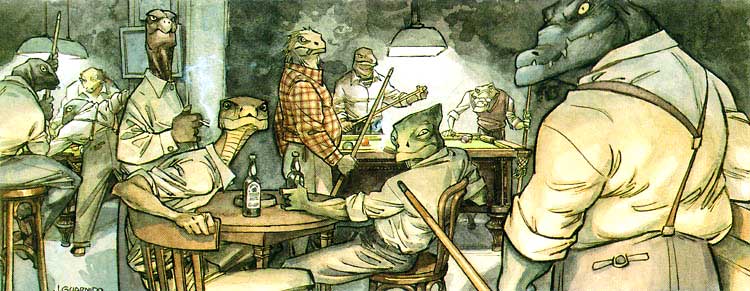
The first volume, Quelque part entre les ombres (Somewhere within the shadows) is more of a prelude, an introduction to the style and setting of the series to come. Blacksad investigates the death of a famous actress, an ex-girlfriend. Faced with dead ends, a police superintendent named Smirnov allies himself with Blacksad to bring the murderer to justice.
Volume two, Arctic Nation, takes place in an economically-depressed suburb and revolves around racism. Blacksad looks into the disappearance of a young girl and finds himself bumping up against a possibly corrupt police chief and a white-furred supremacist group. This case also introduces a character named Weekly, a marten investigative reporter for a tabloid newspaper.
In the third book of the series, Âme rouge (Red soul), Blacksad renews an old acquaintance and prevents him from being murdered within a group of left-wing intellectuals. Things get more difficult when the Cold War government attempts to arrest Blacksad’s friends during the communist witch-hunt.
In terms of buying these comics, only the first two volumes have been translated into English, published in softcover by iBooks, who went bankrupt. (And it happened just as they were also publishing the Furry! The Best Anthropomorphic Fiction anthology.) The first volume is the most gritty of the three, but as mentioned above, the story is more of an introductory one. The second volume is a bit longer with a more complex plot, but the quality of the English translation is slightly lower.
If the language difference doesn’t bother you, it may still be possible to buy the French editions. Failing that, it’s been enormously popular and has been translated into many other European languages. If you can’t find anything through online sellers like Amazon, eBay or AbeBooks, look for French comic stores in Montreal or Quebec (like LeSiteBD/Monet, Fichtre, Imaginaire) to save yourself overseas shipping chages. A Spanish edition is also available in North America from Public Square Books.
If you enjoy anthropomorphic comics that have excellent artwork, I highly recommend having at least one of the Blacksad books in your collection.
A more recent Europearan furry comic to have appeared is La Guilde (The Guild), by Miroslav Dragan and Oscar Martin from Belgium. So far there have been two issues, Astraban (2006) and Lucius (2008).
The main character is Astraban, a young wolf (with a somewhat large nose) who’s just graduated as an alchemist. After he saves a woman being attacked on the street, he finds himself pulled into a local criminal organization. The group is so eager to have him on their side that they go as far as arranging a mock funeral for him, and murdering his family to leave him vulnerable and without ties. At the end of the first issue, he helps his new boss defeat a rival, but by the end of issue two, he’s screwed up big-time. Forced to live on the streets, he earns money by using his alchemical skills to dope a local sports team. After which he’s arrested and sentenced to jail by his former employers. So while the artwork in this comic is cartoony and Disneyesque, the plot definitely isn’t.
Although I’ve enjoyed the story, I’ve had a hard time feeling sympathy for Astraban. Despite being in a situation way over his head, he’s rather naïve, immature and lets his emotions overpower his common sense in situations where he really should know better. Still, I await the next issue to see how he manages. If you don’t mind it being in French, and if you like buying anthropomorphic comics and want to add some international flair to your collection, you might want to pick up a copy of this.
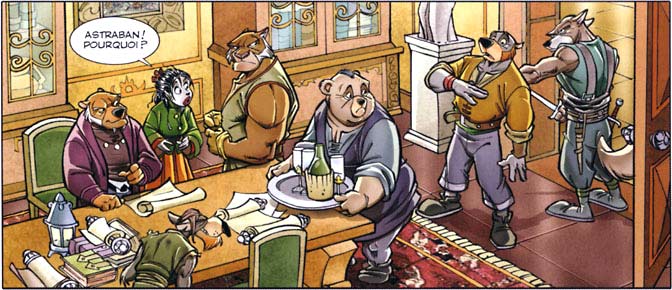
 |
|
|
| Title: |
Les Animaux Amoureux (Animals in Love) |
| Crew: |
Laurent Charbonnier (director); Phillip Glass (score) |
|
Running time, 85 min. |
|
|
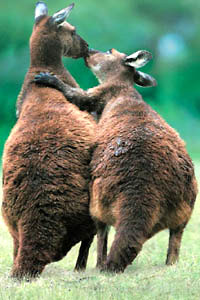 Animals in Love is a 2007 film showing a montage of courting animals. I hesitate to call it a documentary, because aside from brief, unmemorable narrations at its start and the end, nothing is explained, and the end result is more visual than educational. The first half of the film has a definite progression: animals preening, animals making noises to attract potential mates, animals fighting off potential competition, animals trying to impress the ladies.
Animals in Love is a 2007 film showing a montage of courting animals. I hesitate to call it a documentary, because aside from brief, unmemorable narrations at its start and the end, nothing is explained, and the end result is more visual than educational. The first half of the film has a definite progression: animals preening, animals making noises to attract potential mates, animals fighting off potential competition, animals trying to impress the ladies.
The second half of the film stumbles around and occasionally loses momentum. For example, all the underwater footage is dropped in at once and feels out of place. Meanwhile, the animals who’ve managed to find partners start to cuddle, go into rut, or do ritualistic dances with each other. Eventually some get down to business and no, you don’t see anything aside from the standard wiggly hips, for which I am thankful. Then the lucky couples find a place to live, and the kids are born and fed.
There are little moments throughout the film that will make you smile; each of these moments are short and fleeting and will vary from viewer to viewer. Personally I was amused by a lion and a grumpy lioness, some kangaroos pushing each other around, the acrobatics and plumage of several birds, and the beauty of two cranes flying in sync. I had hoped to see short little scenes of affection, and while there were some, it was more about the cycle of life.
In general, there’s nothing in this film that you couldn’t get from watching a nature documentary on the Discovery Channel, which would have the advantage of being shorter and better-explained. The only difference the film has over television is its cinematography—nothing breathtaking, mind you, just a much wider screen ratio. I think it would appeal most to people who like birds, because birds take up at least half of it.
If you’ve got an art-house cinema in your area, Animals in Love has been making the rounds lately and you might get the chance to see it on a big screen. Failing that, a DVD version will be released in France in late August 2008; after that it’ll probably end up on TV at some point. The film has a website that requires Flash. After it’s finished loading (all the birds will fly off the line), you can watch a trailer by clicking at the bottom-left where it says Visionnez la bande-annonce. The soundtrack CD is also available, composed by Philip Glass.
 |
|
|
| Title: |
Nu, Pogodi! (I’ll Get You!) |
| Writers: |
Arkadij Khajt, Aleksandr Kurlyandskij, Feliks Kamov |
| Cast: |
Anatolij Papanov, Klara Rumyanova |
| Crew: |
Vyacheslav Kotyonochkin (director); Svetozar Rusakov (art director) |
|
Soyuzmultfilm, 1969+ |
|
|
Nu, Pogodi! is a series of Soviet cartoons fondly remembered by many Russians from their childhood. The premise is simple—a wolf chases a hare—and the name of the cartoon comes from the wolf’s catch-phrase, which translates roughly to “Well, just you wait!” Although many people have compared it to Tom and Jerry, the original director was not familiar with it.
The humor of the cartoon is largely visual with very little dialogue, so you don’t need to understand Russian to follow it. Aside from the phrase “Nu, pogodi”, the other most common word spoken is “Zayats!” which means “Hare!” Some episodes have elements of Russian culture or folklore worked into them, or in-jokes from earlier episodes, but none of it will detract from following the action.
The Wolf is the main character. A hoodlum of sorts, he’s willing to go to any lengths to capture the hare, and occasionally shows hidden talents along the way. He’s also a heavy smoker. The hare, his quarry, is a kind sort, but dull, and unlike Jerry in Tom and Jerry, the hare doesn’t attack the wolf. Needless to say, the wolf is the more interesting of the two, a bit like Wile E. Coyote, but more well-travelled and without the Acme catalog.
Each episode takes place in a different setting. None of the episodes have titles, and are usually referred to by number. Twenty episodes have been made so far, with the first sixteen produced beween 1969 and 1986. They typically run about nine minutes each, with a title break happening after the first three minutes. Episodes 17 and 18, made shortly after the collapse of the USSR, contain product placement for Nokia.
All in all, this is a fun little cartoon series. A compatible North American DVD with episodes 1-18 is available from russiandvd.com under the title “I’ll get you!”. Individual episodes have also been uploaded to YouTube. The sound and picture quality tends to be somewhat hit-and-miss.
 |
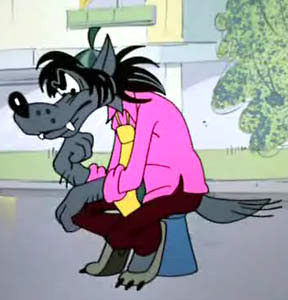 |
Seen any furriness recently that you think other people should know about?
Whether it’s a novel, comicbook, movie, or whatever else, write a review and send it to Anthro!









 The comics scene in France is very different from the North American market. Sure, we know about Tintin and Asterix, but not much else. And that’s sad, because Europe turns out some really high-quality material. Although admittedly there are language differences.
The comics scene in France is very different from the North American market. Sure, we know about Tintin and Asterix, but not much else. And that’s sad, because Europe turns out some really high-quality material. Although admittedly there are language differences.

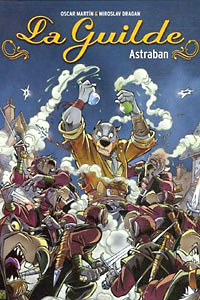
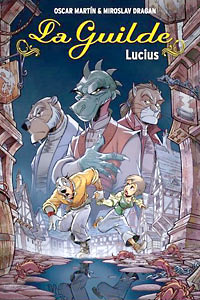


 Animals in Love is a 2007 film showing a montage of courting animals. I hesitate to call it a documentary, because aside from brief, unmemorable narrations at its start and the end, nothing is explained, and the end result is more visual than educational. The first half of the film has a definite progression: animals preening, animals making noises to attract potential mates, animals fighting off potential competition, animals trying to impress the ladies.
Animals in Love is a 2007 film showing a montage of courting animals. I hesitate to call it a documentary, because aside from brief, unmemorable narrations at its start and the end, nothing is explained, and the end result is more visual than educational. The first half of the film has a definite progression: animals preening, animals making noises to attract potential mates, animals fighting off potential competition, animals trying to impress the ladies.

